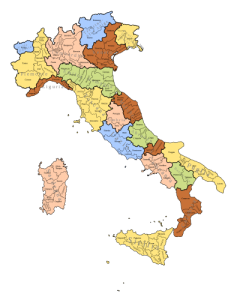Four Endangered Languages of Italy
By Sarah-Claire Jordan
 Just like many countries in Western Europe, Italy is made up of different regions that each have their own distinct culture. The predominant language of Italy, Italian, comes from the Tuscan language, which in turn came from Vulgar Latin, just like all other Romance languages. It may surprise you to know, however, that there are endangered languages spoken in Italy also. We don’t think of Italy or Western Europe as a region that is home to endangered languages, but when you have countries with such distinct regional cultures, you probably have some regional languages to go along with them.
Just like many countries in Western Europe, Italy is made up of different regions that each have their own distinct culture. The predominant language of Italy, Italian, comes from the Tuscan language, which in turn came from Vulgar Latin, just like all other Romance languages. It may surprise you to know, however, that there are endangered languages spoken in Italy also. We don’t think of Italy or Western Europe as a region that is home to endangered languages, but when you have countries with such distinct regional cultures, you probably have some regional languages to go along with them.
Of course, some regional languages have fared better than others. Several are recognized as regional languages by the Italian government, though that still doesn’t necessarily protect them from extinction. Here are four very endangered languages from Italy:
1. Cimbrian
Cimbrian is spoken in the northeastern part of Italy. It is actually the name for a few varieties of Upper German that are spoken in that region, but it is classified as one language. It shares many characteristics with Bavarian, and may have descended from a dialect of Southern Bavarian. There are records of Bavarians migrating to this area of Italy as far back as 1050, and they continued to do so into the 11th and 12 centuries. Oddly enough, no one in Italy really knew that these Germanic language communities existed in Italy until the 14th century.
2. Friulian
Also spoken in an area of northeastern Italy, specifically the Friuli region, Friulian is a Romance language closely related to Ladin, also spoken in northern Italy. About 300,000 people speak Friulian, and they almost all speak Italian as well. It has been influenced by many other languages, including German, Venetian, Slovene, and, of course, Italian. The earliest known documents written in Friulian are from the 11th century, with poetry and literature found that dates back to the 14th century. In the 20th century, there was a big revival of the language, which you can still see today in the many organizations and societies that work to keep Friulian alive.
3. Piedmontese
Moving over to northwestern Italy, we come across Piedmontese, named after the Piedmont region where it is spoken. Over one million people speak Piedmontese, a Romance language related to Venetian and other Northern Italian languages. It is recognized by the government of the Piedmont region, but not by the Italian government, as a regional language. From 1850 to 1950, during the great waves of Italian emigration that occurred, Piedmontese was the main language of emigrants who ended up settling in Brazil, Argentina, France, the U.S., and Uruguay. In Argentina especially, Piedmontese had a huge influence on the Spanish spoken there.
4. Sardinian
On the Italian island of Sardinia, this Romance language is spoken by over 66% of the population. Sardinian has been found to be one of the Romance languages that most resembles Latin, with only an 8% difference in vocabulary, syntax, phonology, and more. It is protected on a regional and national level, though it still is endangered. Due to its isolation from mainland Italy, Sardinian was allowed to retain many of its similarities with Latin as well as evolve on its own without the influence of languages from mainland Europe.
Category: Foreign Language








